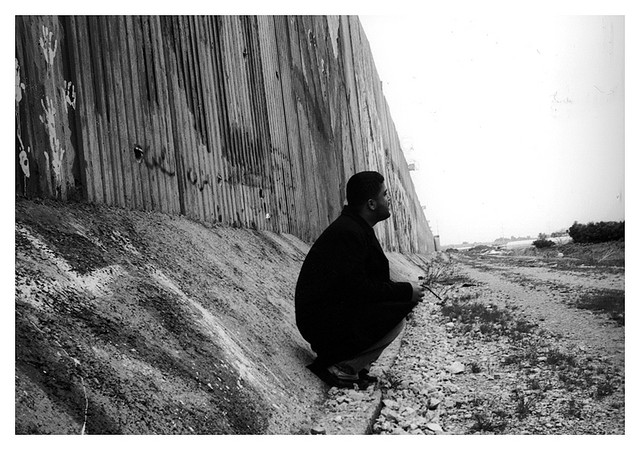by Naomi Dann
Palestinians living under Israeli military occupation experience daily injustices: mass arrests, arbitrary detentions, military raids, separate and unequal legal systems, road closures, restrictions on travel, and settler attacks. However, only when Israeli Jews are killed does the region make the news in the United States and pundits start talking about “escalating violence” and “rising tensions.”
Journalists in both the US and in Israel who wonder whether the recent escalation of violence, including the killing of two Israeli Jews in Jerusalem over the weekend, could be the start of a Third Intifada are missing the point, both about what’s happening on the ground now and what “intifada” means to Palestinians.
The US media frames the story as yet another escalation of Palestinian violence against Israelis resulting in Israeli security crackdowns. But this narrative glosses over the devastating effects such “crackdowns” have on Palestinian civilians, over 500 of whom have been injured and two killed in the last few days alone. The stories date the recent rise of violence in the region to the killing of an Israeli settler couple in the West Bank last Thursday. But taking this event as the starting point for the recent violence ignores the outrage over the Israeli Defense Forces (IDF) killing of a young woman at a checkpoint the week before, an incident Amnesty International has deemed an extrajudicial killing.
What the Intifada Means
The word “intifada,” which for Americans (especially American Jews) and Israelis is equivalent to “terrorism,” is circulating ominously in the US and Israeli media. The literal meaning of intifada is “shaking off.” In Palestinian communities, the word is said with pride to invoke a history of resilience and resistance to occupation, displacement and oppression.
The First Intifada was a relatively coordinated mass protest movement that initially relied on nonviolent tactics such as boycotts, noncooperation, and strikes. In one of the most cohesive moments in the history of Palestinian civil society, communities came together to organize collective nonviolent resistance to military occupation. (For resources about the nonviolent organizing that started the first intifada, see the recently released film The Wanted 18 and Mary Elizabeth King’s book A Quiet Revolution: The Palestinian Intifada and Nonviolent Resistance).
The Second Intifada, which for many Americans and Israelis is synonymous with suicide bombings and rockets, also involved military incursions into Palestinian neighborhoods, mass arrests, the destruction of homes, collective punishment, and the building of the separation wall that divided people from their land and their families. We’ve heard a lot about terrorist attacks on buses, but little about the IDF invasions into the Jenin refugee camp and other attacks on civilians. (Approximately 4,000 Palestinians and 1,100 Israelis died during the Second Intifada. The Israeli blog 972 Magazine has an excellent analysis of the October 2000 massacre of 13 Palestinian civilians and its legacy 15 years later).
The practical effect of intifada, shared in both of these two historical moments, was the unrestricted brutality on the part of Israeli security forces. And in that respect, the situation now may have already reached that tipping point. In a statement yesterday, Israeli Prime Minister Benjamin Netanyahu urged expedited demolitions of homes of Palestinians and asserted that “there are no limitations of the actions of the defense forces.” In the last few days, over 500 Palestinians have been injured, 40 by live fire and nearly 150 by rubber-coated bullets according to the Palestinian Red Crescent. Mobs of settlers are attacking Palestinians while the IDF looks on. And two Palestinian teenagers have been killed. This kind of escalation amounts to collective punishment; the targeting of Palestinians as a whole for the actions of a few.
Whether the next few days bring a de-escalation as the Palestinian Authority enforces the IDF’s will or events spiral out of their control, a long-term solution will clearly require an end to the status quo of injustice.
Looking Ahead
Peace process negotiations ended almost two years ago, and last week Palestinian Authority President Mahmoud Abbas finally announced that the era of Oslo is over. The United States, meanwhile, is implicated in Israeli violations of international law through its ongoing diplomatic and financial support of the government, and thus Washington has never been an honest broker. As a result, advocates of peace are increasingly turning to the tactics of boycott, divestment and sanctions to bring about change.
Over 150 Palestinian civil society organizations issued a call in 2005 for global solidarity through the tactics of boycott, divestment, and sanctions. The call’s three demands encompass the bare minimum of the needs of the main sectors of Palestinian society. Those living in Israel as citizens demand full equality. Those in the Occupied Territories call for the end of the brutal military occupation, including opening up freedom of movement, removing the Wall and checkpoints, and restoring full sovereignty to local communities. And the over 50% of the Palestinian population currently living in diaspora want recognition and a path to realize their right to return to their homes.
These demands leave a lot up in the air in terms of implementation. But how can we expect Palestinians to wait any longer for the status quo to change? When the status quo means collective punishment, mass arrests, displacement from homes, destruction of crops, settler attacks, and stagnation and despair in Gaza, resistance is inevitable.
Photo of the separation wall by http://moty66.ipernity.com via flickr.






Washington would like to start walking the talk by completing its “pivot to the Pacific,” but the continuing mess it has made of the Middle East just won’t disappear. I should think that Bibi and the whole right-wing political elite in Israel is only too happy see that mess continue because if it ever grew quiet, we might see Washington wash its hands of Israel. Then Israel would actually have to attend to its own interests by building bridges with other Middle Eastern countries. That would be worth seeing.